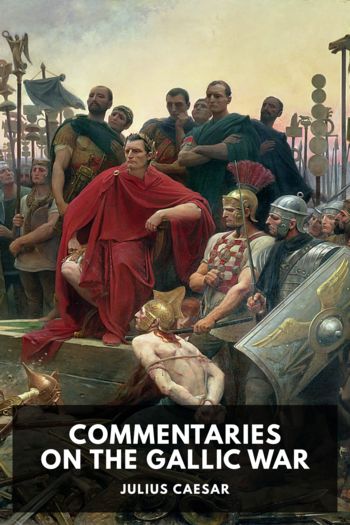Fateful Lightning: A New History of the Civil War & Reconstruction by Allen Guelzo (icecream ebook reader txt) 📗

- Author: Allen Guelzo
Book online «Fateful Lightning: A New History of the Civil War & Reconstruction by Allen Guelzo (icecream ebook reader txt) 📗». Author Allen Guelzo
The most dramatic of these cases, and the one that added the most fuel to the fire of opposition to the Fugitive Slave Act, occurred in Boston, almost under the nose of Garrison’s Liberator. On May 24, 1854, an escaped Virginia slave named Anthony Burns was seized by three federal deputies as he walked home from the Boston clothing store where he worked. White and black Bostonians at once assembled, and on the evening of May 26, a party of abolitionists led an assault on the prison where Burns was held, only to fail in their attempts to retrieve him. President Pierce was determined to demonstrate his support for the Compromise laws and sent in federal troops and Marines to ensure that Burns was put on a ship to carry him back to Virginia. Two Bostonians actually offered to pay Burns’s market price, and more if necessary, to Burns’s owner, an Alexandria merchant named Charles Suttle. The Pierce administration was determined to return Burns to Suttle for the symbolic importance of the gesture. So on June 2, 1854, while thousands of silent, pale Bostonians looked on, Burns was marched to a waiting ship between files of soldiers. The Burns affair was a massive public disgrace, and it drove many Northerners to conclude that slavery itself was a disgrace that deserved extermination rather than assurances. Amos Lawrence, a pro-Compromise Whig, remembered that after the Burns affair, “we went to bed one night old-fashioned, conservative, Compromise Union Whigs & waked up stark mad abolitionists.”35
Even the anger stirred up by the Fugitive Slave Law was limited to the relatively small number of fugitive slave warrants that were actually issued and the even smaller number of fugitives who were actually returned to slavery (probably around eighty in all).36 What brought the plight of the runaway under the Fugitive Slave Law into every Northern parlor was a novel, Uncle Tom’s Cabin; or, Life Among the Lowly, written by Harriet Beecher Stowe, the wife of a theology professor at Bowdoin College in Maine. Stowe was the daughter of Lyman Beecher, a New Englander and one of the best-known Northern evangelicals; her sister, Catharine, was an educator, and her brothers, Edward and Henry Ward Beecher, were both anti-slavery clergymen.
Uncle Tom’s Cabin was Stowe’s first novel, but it drew on a wealth of observation she had acquired when living in Cincinnati in the 1840s while her husband was a professor at Lane Theological Seminary, and a wealth of reading she had done in slave narratives (including that of Josiah Henson, who turns up in Uncle Tom’s Cabin as one of the models for Uncle Tom). In 1851 her sister-in-law urged her to “use a pen if you can” to denounce the Fugitive Slave Law and “make this whole nation feel what an accursed thing slavery is.” “I will if I live,” Stowe announced, and one Sunday shortly thereafter in church, the plot and characters of the novel broke upon her “almost as a tangible vision.” The novel poured out of her pen in a matter of weeks, sentimental and mushy and short on story line, but faultless in its character construction and perfect in its appeal to a sentimental and mushy age.37
The plot can be stated briefly: Tom, the faithful slave of the Shelby family, is sold away from his Kentucky home to pay the debts of his guilt-ridden master. He is purchased by a Louisiana planter, the disillusioned Augustine St. Clare, who believes that slavery is wrong but who cannot imagine a way of life without slaves. Tom wins the hearts of the St. Clare household, especially St. Clare’s frail daughter, Little Eva. In what may be the most saccharine-laden chapter in American literature, Little Eva dies and the remorseful St. Clare resolves to free his slaves. Before that can happen, St. Clare is stabbed in a brawl, and when he dies, Tom is not freed. Instead, he is sold to Simon Legree, whose unalloyed villainy drives him to murder the hymn-singing Tom just before George Shelby, the son of Tom’s old master, arrives to purchase to his freedom. As if this were not enough, Stowe throws in some hair-raising adventure to off set the tackiness of the plot: the escape of the runaway Eliza Harris, who eludes the slave catchers by dashing across the wintry Ohio River, her infant son in her arms, leaping precariously from ice floe to ice floe, and a shootout between Eliza’s husband, George Harris, and the slave-catching posse.
The real genius of the book, however, lies in the care with which Stowe made her chief attack on slavery itself rather than merely taking quick shots at slaveholders. Slavery, for Stowe, was a nameless evil that held well-intentioned Southerners such as the Shelbys and St. Clares as much in its grip as any slave. Stowe made her readers hate slavery, and she made them hate the Fugitive Slave Law, too, for her immediate objective was to awaken Northerners to the hideous realities the new law was bringing to their own doorsteps. “His idea of a fugitive,” wrote Stowe of one stunned Northern character, John Bird, who finds a half-frozen Eliza Harris in his kitchen,
was only an idea of the letters that spell the word… The magic of the real presence of distress,—the imploring human eye, the frail trembling hand, the despairing appeal of helpless agony,—these he had never tried. He had never thought that a fugitive might be a hapless mother, a defenseless child,—like that one





Comments (0)